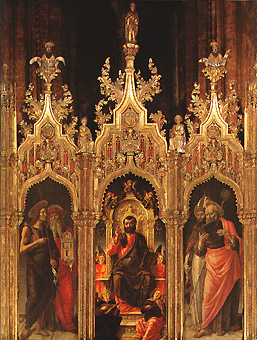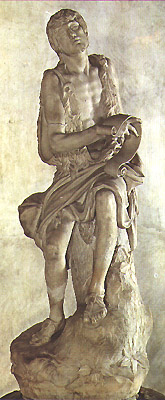Cornaro Piscopia ChapelVenice (S. Polo); Basilica di S. Maria Gloriosa dei Frari
Upon Federico's death the project was assumed by his son Sen. Giovanni Cornaro (SA-46). Sen. Giovanni commissioned the Cornaro-Piscopia Chapel at the Frari, 1417, and dedicated it to his uncle Marco, but a prominent statuary monument in the chapel depicts an angel holding a scroll emblazoned with a funeral elegy to the patron's father Federico. In his guide to the Frari, Luciano Marini calls the sculpture "one of the most beautiful monuments of the Venetian Renaissance, above all for the perfect rhythm of intimate harmony between the noble architectural frame and the sculpted beauty of the figure, all within the precious frieze." A surrounding monochrome fresco is attributed to Andrea Mantegna or his disciple Jacopo Parisati; a marble frieze in the chapel is attributed to Tullio Lombardo. The chapel also contains a 1474 triptych of St. Mark surrounded by Angels, flanked on the left by St. John the Baptist and St. Jerome and on the right by St. Peter and St. Nicholas, executed by Bartolomeo Vivarini, 1474. Lorenzetti has praised the work as "a masterpiece of styization and polychromy."
Home
| Palaces | Chapels
| Villas | Paintings
| Theaters |

 Finally, the chapel houses an evocative
statue of St. John the Baptist executed by
Finally, the chapel houses an evocative
statue of St. John the Baptist executed by